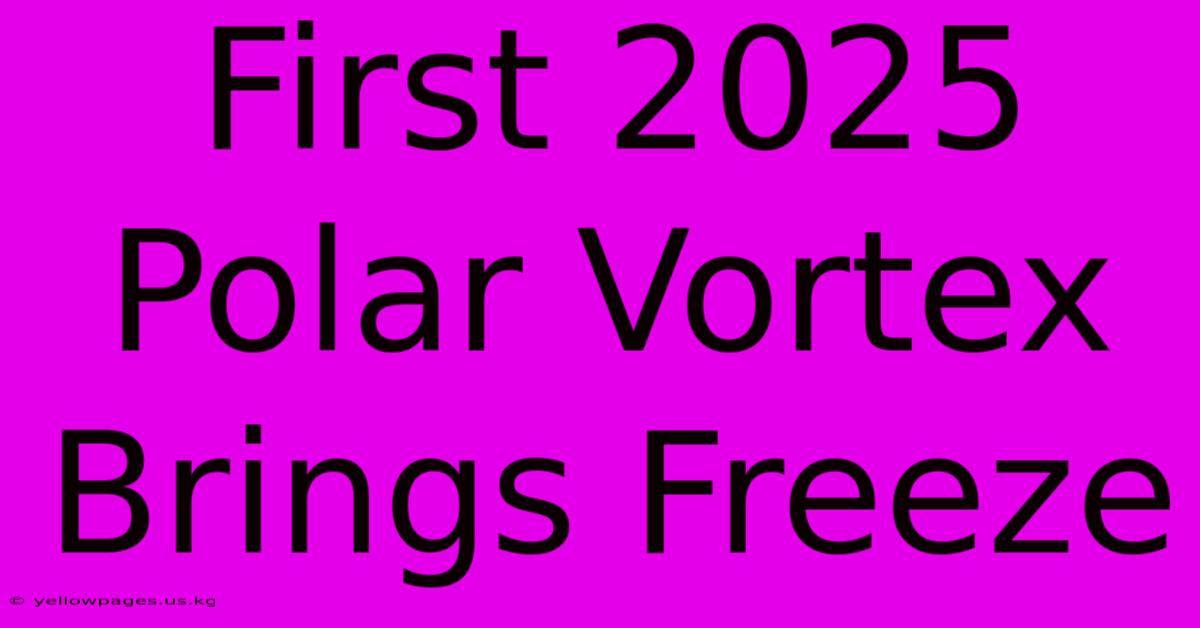First 2025 Polar Vortex Brings Freeze

Discover more detailed and exciting information on our website. Click the link below to start your adventure: Visit Best Website trendingnews.us.kg. Don't miss out!
Table of Contents
First 2025 Polar Vortex Brings Freeze: A Deep Dive into the Early Arctic Outbreak
The year is barely underway, and already the 2025 polar vortex is making headlines. An unexpectedly early and intense outbreak has sent temperatures plummeting across much of the Northern Hemisphere, leaving many wondering: what's happening, and what can we expect?
Understanding the Polar Vortex
Before we delve into the specifics of this early freeze, let's establish a baseline understanding of the polar vortex. The polar vortex isn't a single entity, but rather a large area of low pressure and cold air surrounding both of the Earth's poles. This swirling mass of frigid air usually stays contained within the Arctic and Antarctic regions. However, sometimes, the vortex weakens and becomes distorted, allowing frigid air to spill southward into more temperate zones. This phenomenon is what leads to those extreme cold snaps we often hear about in the news.
Factors Contributing to Vortex Disruptions
Several factors can contribute to a disruption of the polar vortex, including:
- Sudden Stratospheric Warmings (SSWs): These events involve a rapid increase in temperature within the stratosphere, which can weaken the polar vortex and lead to its displacement.
- Climate Change: While the exact relationship is still being studied, some research suggests that climate change could be altering the jet stream, making it more prone to disruptions and increasing the frequency of polar vortex outbreaks.
- Natural Variability: The polar vortex naturally fluctuates in strength and position. Some years are naturally more prone to southward excursions of cold air.
The 2025 Early Freeze: A Closer Look
This year's early polar vortex event is particularly noteworthy due to its unexpected timing and intensity. While early outbreaks aren't unheard of, the severity of the temperature drop and the geographical extent of its impact have caught many meteorologists by surprise. Preliminary reports suggest record-breaking low temperatures in several regions.
Impact and Consequences
The consequences of this early freeze are wide-ranging:
- Infrastructure Disruptions: Extreme cold can lead to power outages, transportation delays, and damage to infrastructure.
- Economic Impacts: Business closures, supply chain disruptions, and increased energy costs all contribute to significant economic losses.
- Health Concerns: Cold weather poses health risks, particularly for vulnerable populations, including the elderly and those with pre-existing health conditions. Hypothermia and frostbite are serious concerns.
- Agricultural Impacts: Unseasonably cold temperatures can severely damage crops and livestock.
Preparing for Future Events
While predicting the precise behavior of the polar vortex remains a challenge, understanding the factors that contribute to its disruptions is crucial for preparing for future events. Investing in infrastructure improvements that can withstand extreme weather conditions is essential. Furthermore, developing better forecasting models and early warning systems can help mitigate the impact of future polar vortex outbreaks.
Individual Preparedness
On an individual level, taking steps to prepare for extreme cold weather is vital. This includes:
- Having an emergency kit: Stock up on essential supplies, such as food, water, blankets, and medications.
- Protecting your home: Insulate your home properly and take steps to prevent frozen pipes.
- Monitoring weather reports: Stay informed about weather forecasts and heed any warnings issued by authorities.
The early 2025 polar vortex outbreak serves as a stark reminder of the power of nature and the importance of preparedness. While the exact causes and long-term consequences are still being investigated, this event highlights the need for continued research, improved infrastructure, and increased individual awareness of the risks associated with extreme weather events. Staying informed and taking proactive steps can help us minimize the impact of future cold snaps.

Thank you for visiting our website wich cover about First 2025 Polar Vortex Brings Freeze. We hope the information provided has been useful to you. Feel free to contact us if you have any questions or need further assistance. See you next time and dont miss to bookmark.
Featured Posts
-
Jolie Pitt Divorce Finally Settled
Jan 01, 2025
-
Nyc Subway Fire Victim Id D As Debrina
Jan 01, 2025
-
Playoff Bracket Scores And Schedule
Jan 01, 2025
-
Todays Bowl Games Tv Schedule And Channels
Jan 01, 2025
-
Angelina Jolie Brad Pitt Divorce Settled
Jan 01, 2025
